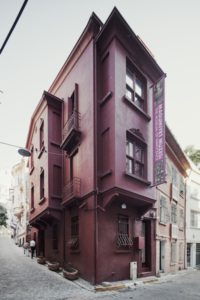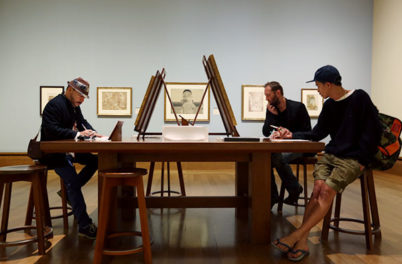
Orhan Pamuk at his Museum of Innocence in Istanbul, standing amid the numbered vitrines. Photo: Innocence Foundation and Refik Anadol, masumiyetmuzesi.org
I first became engaged with the work of Orhan Pamuk not through one of his acclaimed novels such as Snow or My Name is Red, or even when he was awarded the Nobel Prize in Literature in 2006. Rather, ever since I discovered that the influential author had written a Modest Manifesto for Museums to accompany his novel and museum, both called The Museum of Innocence, he has constantly been on my mind. Point number six of Pamuk’s 11-point manifesto hit close to home:
“Big museums with their wide doors call upon us to forget our humanity and embrace the state and its human masses. This is why millions outside the Western world are afraid of going to museums.”
While I haven’t done a systematic survey of the size of museum doors around the world, it’s difficult to imagine any museum having wider doors than the Getty’s magnificent sliding glass portal through which visitors pass on their way out of the Entrance Hall toward the museum’s pavilions. The curved door, designed by Richard Meier, is so substantial that opening it requires the assistance of a machine to slide it along its curving track.
Pamuk’s manifesto, however, is not a treatise on museum buildings, which has been an obsession for starchitects and their patrons. Rather, it expresses Pamuk’s love-hate relationship with our temples of culture. Pamuk—who before becoming a novelist dreamed of being a painter and architect—writes in the preamble to his manifesto: “I love museums and I am not alone in finding that they make me happier with each passing day. I take museums very seriously, and that sometimes leads me to angry forceful thoughts.” Pamuk’s manifesto envisions a different sort of museum for the future, one that presents humanistic and personal stories, rather than authoritative histories of nations and empires. Consider some of the other points of the manifesto:
- Large national museums such as the Louvre…present the story of the nation—history, in a word—as being far more important than the stories of individuals. This is unfortunate because the stories of individuals are much better suited to displaying the depths of our humanity.
- We don’t need more museums that try to construct the historical narratives of a society, community, team, nation, state, tribe, company, or species. We all know that the ordinary, everyday stories of individuals are richer, more humane, and much more joyful.
- Demonstrating the wealth of Chinese, Indian, Mexican, Iranian, or Turkish history and culture is not an issue—it must be done, of course, but it is not difficult to do. The real challenge is to use museums to tell, with the same brilliance, depth, and power, the stories of the individual human beings living in these countries.
- It is imperative that museums become smaller, more individualistic, and cheaper. This is the only way that they will ever tell stories on a human scale.
- Monumental buildings that dominate neighborhoods and entire cities do not bring out our humanity; on the contrary, they quash it. Instead, we need modest museums that honor the neighborhoods and streets and the homes and shops nearby, and turn them into elements of their exhibitions.

The Museum of Innocence, Istanbul. Photo: Innocence Foundation and Refik Anadol, masumiyetmuzesi.org
Pamuk enacted his manifesto by opening The Museum of Innocence in a modest 19th-century house in the Çukurcuma neighborhood of Istanbul, said to be the home where the novel’s protagonist Kemal Basmaci lived from 2000 to 2007. The museum shares more than a name with Pamuk’s novel, which has been translated into almost 40 languages. The written work and the museum were developed together from the beginning, as Pamuk collected over a thousand artifacts and knick-knacks in Istanbul’s junk shops and various other unanticipated locations to build his narrative. As ordinary objects—a quince grater, a postcard, some keys—became part of the story, they were infused with Kemal’s memory of his beloved Füsun, whom he cannot marry. (The book was published in 2008, four years before the museum opened.)
The museum, which I visited last summer, consists of 83 numbered, lovingly crafted display cases corresponding to the 83 chapters in the novel, each containing objects connected to the book’s characters. (The museum does have at least one advantage over the book, as the audio guide notes: “This is a museum not a novel, so if you ever get bored, skip to the next section.”) The narrators on the museum’s audio guide lead listeners through the experience, situating the displayed objects in the lives of Kemal and those around him. The recorded voices frequently shift from explanations to monologues culled from Kemal’s thoughts as he recalls memories conjured by the objects.

A vitrine/chapter titled “My Father’s Death,” in the Museum of Innocence. Photo: Innocence Foundation and Refik Anadol, masumiyetmuzesi.org
Here the boundary between the fiction of the story and the reality of objects bends. On the audio guide we hear the voice of Orhan Pamuk, the prize-winning author, who welcomes us to his museum and intermittently shares information about the museum-making process: “While making the museum, we frequently came face-to-face with the serendipitous nature of beauty.” But we also encounter the Orhan Pamuk who intimately knew Kemal, the novel’s protagonist, and who shares observations on his life of unfulfilled love. The characters of the novel come to life for us as we glimpse their experiences through display-case glass and accompanying words, much as the ancients might take shape in our minds as we see their artifacts and learn their mythologies.

Photo: Innocence Foundation and Refik Anadol, masumiyetmuzesi.org
Do the Museum of Innocence and its kin—the Museum of Jurassic Technology here in Los Angeles, Das Museum der Unerhörten Dinge (Museum of Extraordinary Things) in Berlin, for example—pose a challenge for the large national museums housed in monumental buildings that Pamuk would have them supplement? No doubt big museums with grand historical narratives will continue to receive funding, fill the pages of guidebooks, and stand as symbols of national pride, unthreatened by the proliferation of smaller, alternative museums. But perhaps the museums “with wide doors” can learn from the narrative, inventive impulses of smaller institutions.
Objects, whether they are found in junk stores, our own attics, or auctioned at Sotheby’s, encapsulate stories and can unleash our imaginations. If we shroud artifacts in authoritative information, construct historical narratives around them, and continue what Pamuk calls, in the audio guide, the soulless tradition of state-sponsored museums displaying artifacts in sequence, we quash possible creative reactions to museum displays, dehumanizing the museum encounter. We need to remember, as we are told at museum box/novel chapter #47, that “objects placed side by side can bring forth unusual emotions and thoughts.”
_______
Hear Orhan Pamuk discuss his latest novel, A Strangeness in My Mind, with L.A. Times book critic David Ulin on Wednesday, October 28, at the Getty Center. Get free tickets here.




Hi Peter,
My husband and I also visited Istanbul this summer, and high on my list (though not higher than Haghia Sophia) was the Museum of Innocence, having read this and every book Pamuk has written since My Name is Red. You allude toward the end of your essay what seemed to me the magical feature of the place – that it was curated by the author as he was writing the book, which seemed to me an exciting creative exercise. The result is fascinating – if exhausting (yes, we did accept Pamuk’s invitation to skip along at points) – the staff told us the entire experience should last about 3 hours. While every curator works within the magical effect created by the juxtaposition of objects, what I loved the most at the Museum of Innocence was the top floor, Kemal’s bedroom, with large flat vitrines holding all the cigarettes he smoked while waiting for Fusun (who really smoked these? Pamuk?) and even more, pages from the original notebooks in which the novel was written accompanied by the empty ink cartridges of all (?) the pens he used to write this novel.
But as I left the Museum of Innocence, I wondered if it would outlast its author/creator, and the relevance of that situation to all the worlds museums.
Thanks for your post and I look forward to the lecture very much.
Over the past two years, we have curated something called the ‘Museum of Ordinary Objects’, at Harkat Studios in Mumbai. This article adds so much clarity to what we attempted to do but never articulated in such a beautiful way and nor did any of the Mumbai press. Thank you for this.
And we look forward to bringing our curation to the world and maybe even to you at some point.
a chi consegnare il futuro dei musei…cosa?